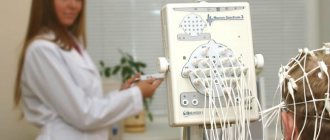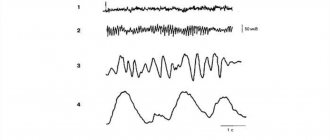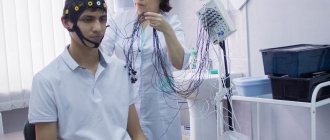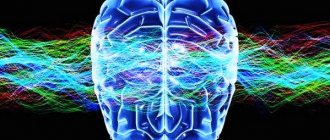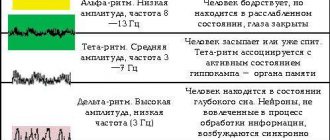Neuron: fiber, nerve.
The function of neurons is to create and conduct nerve impulses. A typical neuron takes 1 microsecond to respond to a stimulus. Millions of neurons respond in unison, producing “swinging” electrical discharges. This response creates a brain rhythm called a “brain wave.” The state of our consciousness reflects the mixed activity of the rhythms of such waves. Electroencephalogram - EEG - the total electrical activity of many neurons in the brain, recorded from the surface of the head. Frequency is the number of times a wave oscillates per second. Amplitude is the strength of the electrical impulse. Based on frequency, brain activity waves are divided into four main categories of brain rhythms: Alpha, Beta, Theta and Delta. Information about brain wave patterns is taken from the book “Inspiration by Order” by Anna Weisz , where they are described in detail, and exercises for balancing the intellect are also given there. The information presented below does not contain practical advice, only a description of the circuits. Internet resources were also used.
"Mirror of Consciousness" for measuring brain waves
This is the first device to perform spectral analysis in real time by taking EEG. The device measures the frequencies of brain waves in both hemispheres of the brain, precisely at the moment when they were produced. In this way, patterns of brain activity waves were obtained.
Active Intelligence Diagram
– combination of meditation with mental activity. This occurs at certain proportions of the four main waves, while:
- the thought process goes smoothly
- feelings and emotions become more understandable and manageable
- information moves easily between different levels of consciousness
- intuition manifests itself as an integral part of consciousness
An active state of intellect appears at the moment of creative inspiration. The same pattern is observed:
- a mathematician solving a complex problem
- scientist performing an important experiment
- leader making an important decision
The obtained patterns, both active balance and deviations from it, suggest that there is a vibrational language with its own alphabet (schemes), which underlies more complex vibrational structures. Rhythm is one of the key factors in coordinating the activity of the cerebral cortex. If people can control their mind patterns, they will be able to enter different states of Being.
Ways to stimulate alpha waves
On the EEG, alpha rhythms can be observed only in cases when the human body is completely relaxed. Those observed in this state are distracted from problems, so stress is relieved. A slowdown in mental activity has also been noticed, so the consciousness is “cleared”. This allows you to create new ideas, increases the creativity of mental activity, and gets rid of the creative crisis.
If a person experiences severe and prolonged brain activity for some time, then the normal activity of the organ stops. The solution to this problem is to increase alpha waves and relieve mental stress.
There are many techniques that allow you to have a stimulating effect on alpha waves:
- Sound waves. A simple and accessible technique in all respects, with the help of which alpha activity increases, and the process itself brings a “dose of pleasure” to a person. The technique consists of listening to special music, which consists of stereo sounds.
- Yoga. Long-term yoga exercises, provided the exercises are performed correctly, act as a powerful activator of alpha activity in the brain, which can moderately and not dramatically increase the necessary indicators.
- Meditation. With the help of meditation, you can teach your body to relax automatically, but this will require spending a lot of time going through a huge number of practical sessions.
- Breathing exercises. The method implies that the person will have to constantly maintain deep breathing. This process saturates the brain cells and internal organs with oxygen. If you do breathing exercises systematically so that it becomes a habit, the creation of alpha waves will occur automatically.
- Hot baths. Relaxation almost always occurs after taking a hot bath, which also eliminates fatigue. The production of alpha waves is the main reason for the relaxation of muscle structures.
- Alcohol. Not a recommended method, which, oddly enough, also allows you to activate production and get an increased level of alpha waves. Alcohol is used by many people to relieve stress. Immediately after drinking alcohol, alpha waves begin to form, which allows a person to enter a state of relaxation, detachment from the world and relaxation.
Beta brain rhythm - active state
The left hemisphere is dominant.
Fast waves that correspond to states ranging from normal thinking to panic. Associated with accelerated metabolism and high blood pressure. Associated with wakefulness, concentration, cognition, decision making. A similar brain rhythm for comparison is the rhythm of drums.
Anxiety, fear, panic - Beta waves dominate . Depression, poor attention and memory of information are a lack of Beta waves .
Steady Beta Waves:
- The right part of the brain turns on chaotically: figuratively - sensual
- The left side is overstrained: thinking, decision-making.
- the main idea dominates: I must survive here and now
- mentality is limited to the concepts of “I” and “mine”
- an almost constant feeling of dissatisfaction with oneself and one’s life.
High level beta waves from 23 - 30 Hz.
People of this type often exhibit characteristic behavior:
- smoking, overeating, gambling
- drug or alcohol addiction.
Having a strong sensitivity to external stimuli and quick reactions, they achieve success, but even ordinary events can be stressful and this pushes them to alcohol and drugs to relieve stress.
Beta waves
Another type is beta brain waves. They are recorded in the range from 14 to 30 vibrations per second. Such fast waves are normal and are activated when a person is involved in the world around him. They are also actively emitted when excited, stressed or anxious. In order for them to begin to dominate, it is enough to start a conversation with any person
All the attention of people with dominant beta waves is directed to the environment
You can develop beta rhythms through normal active life. Any communication, physical activity, manifestation of a social position, stress, fears - all this contributes to their increase. You can reduce their activity by simply relaxing and giving up negative thoughts.
There are three types of beta waves. They are separated for a more accurate characterization of several intervals, because The frequency range is quite large, and the sensations may be different. The following types are distinguished:
Low (13-16 hertz). When the activity of brain neurons begins to emit impulses at this pace, weak involvement in the world around us begins to appear. This activates the left hemisphere of the brain. The person loses the feeling of relaxation, but there is still no arousal
With regular training of this frequency, the skill of managing concentration and attention will appear. Medium (16-18 hertz). At such frequencies the right hemisphere of the brain is connected to work
An awareness of one’s “I” and surrounding things appears. People start to feel a little excited and involved in the world. When performing training, intellectual abilities and concentration will develop. High (18-30 hertz). Such waves are compared to driving fast in a sports car. The sensations are similar to those when a lot of adrenaline is released. Strong excitement and interest in the world around us and everything that happens appears.
The alpha rhythm of the brain is associated with forms of thinking, with the nature of images.
At the early stages of development, the human brain acquired a mechanism whose action is manifested in calculation, foresight and imagination. Later, processes of abstract thinking and control emerged - what we call will.
Generation of alpha waves: a person dreams, fantasizes, activates visualization. The eyes are closed, passive, thoughtless relaxation occurs, bioelectrical oscillations in the brain slow down. A state of sensory peace, deep mental relaxation, and a meditative state arises. It is a gateway, an entry point that leads to deeper states of consciousness. An analogue of the alpha rhythm of the brain - the piano is playing calmly.
Stimulation of brain rhythm in the Alpha range:
- ideal for learning new information
- the speed of muscle reaction is ten times higher than in the normal state
- the brain produces more of its own “drugs” responsible for joy, relaxation and pain reduction.
Make your own choice
Most of the information - traumatic experiences, messages from significant adults - bypasses our consciousness and ends up at the unconscious level. This level has a huge influence on us, often even controls our lives. The more a person studies his unconscious and preconscious and transfers information to a conscious level, the more choices he has.
So, the daughter of an alcoholic, on a conscious level, is looking for a teetotaler as a husband, but her entire unconscious is literally permeated with information that a woman should devote herself to a man, save him, that she is not worthy of a healthy relationship. This is most likely how her mother or grandmother behaved. And she didn’t see any other scenario. Daughters of alcoholics in more than 50% of cases marry alcoholics (V. Moskalenko. Addiction: a family disease).
If this woman had been aware of her unconscious processes and learned how to interact more constructively with men, she would have had a better chance of finding a healthy partner. Until that happens, she has no choice.
Theta brain rhythm - relaxed state
The theta rhythm of the brain is recorded:
- in a relaxed state, in light sleep with dreams
- deep meditation
- in the process of accelerated learning and in healing.
Brain vibrations become slower and more rhythmic. The action of defense mechanisms decreases, which makes it possible for information to penetrate deep into the subconscious, and liberation from suppressed emotions and mental blocks occurs. It is the twilight state between sleep and wakefulness that allows access to the unconscious part of the mind. An analogue of the theta rhythm of the brain is the cello.
Theta is a waking dream, vivid images flash before the mind's eye, and sensitivity to information outside of ordinary consciousness increases. Provides access to free associations, unexpected insights, and creative ideas. This brain state has a name: hypnagogic. The theta rhythm of the brain allows you to see God in everything, recognize patterns and cycles. At this stage, revelations and prophetic dreams often come to us. In the Theta state, powerful shamans and enlightened Yogis create.
Hypnagogia is the state immediately preceding sleep. Hypnagogic states are usually characterized by the presence of images (visual, auditory, kinesthetic, etc.), but an almost complete absence of narrative.
Edison worked very hard on his inventions. When he reached a dead end, he would sit in a chair, take a metal ball in his hand, which he freely lowered along the chair, and fall asleep. Having fallen asleep, he involuntarily let go of the ball from his hand and the roar of the ball falling to the floor woke him up. Often this was accompanied by fresh ideas about the project he was working on. Salvador Dali spent his daytime sleep sitting in a chair, holding a spoon in his hand, but as soon as sleep overcame him, the spoon fell onto an iron tray on the floor. This ringing sharply awakened him, which allowed him to find new ideas. He borrowed this method of switching consciousness to a different brain rhythm from the Cestercian monks.
Images generated by Alpha waves:
- more distinct, clear and understandable
- boundaries are clearer
- colors are more varied
Images generated by Theta waves:
- darker and less clear
- carry deep meaning
- rise from the depths of consciousness.
These images are perceived as insight or a gift from above, sometimes they are surrounded by light. Their appearance is often accompanied by a feeling of some kind of knowledge, an understanding that this image suggests the right decision, that it touches something in the depths of your consciousness. It happens that before the appearance of images of Theta waves, a person sees blue and violet waves. This indicates the activation of strong Theta waves.
In most modern people, the activity of Theta and Alpha waves is reduced. With the help of coffee, they wake up from deep sleep - Delta and push themselves into a state of active wakefulness - Beta. Working all day in the Beta range, in the evening they fall into deep sleep - a rough switch of the brain from Beta to Delta occurs. The brain is not given the opportunity to work at the frequencies of the soul - Alpha and Theta brain rhythms. Stimulants (coffee, etc.) - suppress Theta and Alpha waves, increasing the proportion of Beta waves, which is comparable to strained and hysterical singing.
Age-related dynamics of the rhythms of electrical activity of the brain. Anxiety level and EEG indices 2164
The study of age-related patterns of electrical activity of the cerebral cortex is a necessary condition both for the further development of a theoretical understanding of the formation of brain functions and mental processes, and for the practical provision of normal physiological and mental development of a child in various social conditions. Consideration of the process of development of the cerebral cortex from the standpoint of systemogenesis allows us to analyze, compare and contrast the mental and physiological characteristics of its maturation in the continuity of the behavioral continuum (Alexandrov, Sergienko, 2003, p. 98). According to the laws of systemogenesis, as individual structures of a functional system undergo heterochronic maturation in interaction with an increasingly complex environment, a transition from less differentiated to more highly differentiated behavior is observed (Shvyrkov, 1995; Aleksandrov, 1995, 2009; Chuprikova, 1990; Sergienko, 2009, etc. ).
It is known that the development of EEG rhythms of the brain in phylogenesis involves a gradual transition of the dominant brain rhythm from low-frequency to higher-frequency. For example, in reptiles the delta rhythm dominates, in lower mammals the theta rhythm dominates (MacLean, 1990). G. G. Knyazev (2004) considers delta, theta and alpha rhythms as a hierarchical system that is in relation to three evolutionary systems of the brain - stem, limbic and corticothalamic. According to this theory, the delta rhythm is associated with vital and biological motivations, the alpha rhythm reflects the processes of “perception and recognition of environmental patterns,” and the theta rhythm reflects emotional processes (Knyazev, 2004, p. 572). From the point of view of Yu. I. Alexandrov, emotions characterize evolutionarily early, “old” brain systems with low differentiation of functions (Alexandrov, 1995, 2006), which are probably associated with the predominance of slower rhythms in the EEG. The increasing complexity of environmental differentiation contributes to the development of “new” highly differentiated systems, which is accompanied by an increase in faster waves of electrical activity as a person grows older; similar dynamics are also observed in ontogenesis.
The ontogenetic aspect of the development of EEG rhythms of the brain was touched upon by many researchers - initially in the form of a description of linear and then nonlinear changes in slow waves towards decrease and fast waves towards increase with age (Matousek, Petersen, 1973; John et al., 1980; Matthis et al., 1980; Gasser et al., 1988, etc.). This pattern, from the standpoint of a systems approach, can be represented as a decrease in the coefficient expressing the ratio of “the number of less differentiated systems to the number of more differentiated systems” as the differentiation of relationships with the external environment becomes more complex (Alexandrov, 2006, p. 316). Many researchers highlight the increase in the leading alpha rhythm as one of the main criteria in determining the degree of morphofunctional maturation of the brain of children (Dubrovinskaya, 1985; Farber, 1969; Farber, Alferova, 1972; Blagosklonova, Novikova, 1994; Biyasheva, Shvetsova, 1981, etc.). The intensity of systemogenesis varies both in space and time. The most intense age-related changes are observed in the first weeks after birth (Anokhin et al., 1996). According to anatomical studies, maturation occurs in the continuous dynamics of transitions of progressive and regression processes and the maximum intensity is observed during the age period of up to two years. Longitudinal MRI studies have revealed increases in white matter throughout the brain and local changes with U-shaped gray matter dynamics at different rates in different structures (Lenroot and Giedd, 2006). The maximum intensity of the increase in synaptic density in the visual areas was observed at four months, and in the prefrontal cortex only at four years. The processes of decreasing slow rhythms and increasing fast rhythms occur faster in the parieto-occipital than in the anterior regions of the brain (Taylor, Baldeweg, 2002; Werkle-Bergner et al., 2006), and the trajectory of maximum brain plasticity changes in the same direction (Chugani et al. al., 1987).
The degree of functional maturation of the brain corresponds to the degree of development of mental processes. Long-term studies of the maturation of brain activity made it possible to determine EEG criteria for the functional maturity of regulatory structures from degrees I to IV (Farber, 1969; Farber, Bezrukikh, 2001; Machinskaya et al., 1997, etc.). The results of other studies have shown that functional maturity correlates with children’s academic performance and attention functions (Machinskaya et al., 1997; Machinskaya and Krupskaya, 2008). M. Werkle-Bergner et al. (2006), using MRI and EEG methods, attempted to consider the process of functional maturation of the brain and changes in memory functions from the point of view of anatomical and physiological age-related transformations. According to cognitive models, new maturing structures require the involvement of earlier structures to reflect higher-level ideas and concepts (Shrager & Johnson, 1996). It should be noted that the results of the studies presented above are consistent with the main provisions of the systems approach: “new”, more highly differentiated structures constantly require the involvement of “old” ones, since they are not interchangeable, but “layered” (Shvyrkov, 1995; Aleksandrov, 1995, 2006, 2009).
Of course, the environment influences the formation of electrical activity of the brain in the process of individual development. Thus, children growing up in conditions of increased risk of disease show a slower decrease in the theta rhythm and pronounced variability in various EEG rhythms compared to children growing up in more favorable conditions (Harmony et al., 1988). Children in conditions of family deprivation are characterized by different dynamics of development of understanding of emotions than children raised in families (Sergienko, 2006). Some studies have noted a certain specificity in the development of the intellectual and affective-need spheres in children under conditions of maternal deprivation, which manifests itself in the impoverishment of the emotional and motivational sphere, focus on external control, self-rejection, distrust of people, destructive aggression (Prikhozhan, Tolstykh, 2005; Prikhozhan, 2000), which, from our point of view, should be reflected both in indicators of the level of functional maturation of brain activity and in indicators of the level of anxiety in children.
There are studies confirming the fact that anxiety is a precursor to many mental and somatic diseases, deviant and addictive behavior, which determines the need for its diagnosis in the early stages before the appearance of the first symptoms of an acute psychosomatic disorder or behavioral abnormalities (Siciliani et al., 1975; Smit et al., 2007; Blackhart et al., 2006; Pavlenko et al., 2009, etc.). The authors suggest the use of EEG indicators as good indicators of anxiety. In particular, they suggest that higher EEG activity in the right frontal zone is associated with symptoms of depression, anxiety, and increased emotionality (Blackhart et al., 2006). Anxiety is also associated with a coupling effect between slow and fast EEG waves (Knyazev et al., 2005, etc.). Some studies note higher levels of delta and beta activity and lower levels of alpha activity in highly anxious individuals (Pavlenko et al., 2009; Cherny, 2007, etc.).
Thus, the goal
This study revealed differences in indicators of age-related dynamics of cerebral cortex activity (indicators of the spectral power of the main EEG rhythms) and the level of anxiety between two samples of subjects - children living in an orphanage and children in the control group.
Research hypotheses:
1. The dynamics of the development of EEG rhythms in the examined children corresponds to the general pattern of a decrease in the spectral power of low-frequency rhythms and an increase in high-frequency rhythms in ontogenesis.
2. The age-related dynamics of changes in EEG rhythms differs among subjects of two main samples: among children raised in a family environment and inmates of an orphanage.
3. The level of anxiety in group D is higher compared to the level of anxiety in children in the control group, which is reflected in the EEG indicators.
Subjects.
The study involved 115 children, divided into the following age groups: I – from 6 to 7 years (20 people), II – from 11 to 12 years (40 people), III – from 14–15 years (35 people). ), IV – from 17 to 18 years (20 people). Of these, 40 children lived in an orphanage (groups D: II - 20 people and III - 20 people), 55 people studied at a high school-gymnasium, lived with families (groups K: I - 20 people, II - 20 people, III –15 people). Age group IV (K: IV–20 people) included 1st year students of the Al Farabi Kazakh National University (Almaty). The groups were balanced by gender (50% girls and 50% boys, with the exception of control group III, which included 7 boys and 8 girls).
Methodology
Anxiety.
The level of anxiety was determined using the C.D. Spielberger test, adapted by Yu.L. Khanin (1976), before conducting an EEG study.
EEG study
. EEG recording was made monopolarly from eight symmetrical frontal (F3, F4), central (C3, C4), parietal (P3, P4) and occipital (O1, O2) brain regions using a 10–20% system with an indifferent ear electrode using a computerized electroencephalograph (Hungary), equipped with EEGlab software (Vildavsky, 1996). The subjects were in a darkened room, isolated from noise and electromagnetic waves.
The EEG recording procedure included situations:
1. Quiet wakefulness with eyes closed (2 min); 2. Calm wakefulness with eyes open (2 min.); 3–7. Photostimulation 4, 6, 8, 10, 12 Hz (FS, sequentially for 30 sec); 8. Hyperventilation (HV, 2 min); 9. Recovery after breastfeeding (2 min); 10. Breath holding (BH, 30 sec);
11. Recovery after exercise (1 min). This work presents only indicators of the spectral power of background values with eyes closed and open, hyperventilation and recovery after hyperventilation.
EEG analysis.
Spectral coherence analysis based on fast Fourier transform of data was carried out using V. Wildavsky’s program after removing EEG segments containing artifacts for the following EEG rhythms:
delta
– 0.2–3.8 Hz;
theta
– 4–7.8 Hz;
alpha1
– 8–10.8 Hz;
alpha2
– 11–13.8 Hz;
beta1
– 14–19.8 Hz;
beta2
– 20–29.8 Hz;
gamma1
– 30–34.8 Hz; gamma2 – 35–45 Hz. Individual indicators of power spectral density (PSD) and coherence function (CoF) of EEG rhythms for each studied situation were transferred to the SPSS15 file, where further statistical processing was carried out. All data underwent the normalization procedure Y=logХ. Alpha mode in age groups was determined using graphs in Wildavsky software.
Statistical hypotheses
:
Hypothesis 1
. One-way analysis of variance (one way ANOVA) based on post hoc tests using the LSD and Bonferroni criteria for total and local indicators of the spectral power of various rhythms and EEG indices (Theta/Alpha2, Alpha/Delta, GW and post-GW recovery indices, alpha suppression index -rhythm when opening the eyes) suggests obtaining statistically significant differences between age groups.
Null hypothesis: significant differences in the total and local spectral power of rhythms and EEG indices between age groups are not observed.
Hypothesis 2
. The total and local spectral power of EEG rhythms differed significantly in groups D and K in the range of slow waves (multivariate analysis of variance, MANOVA). The alpha mode in the corresponding age groups for children of group D has a lower value than for children of group K (Vildavsky program).
Null hypothesis: no significant effect of the influence of the social factor on EEG indicators. The alpha mode values do not differ in groups D and K. Hypothesis 3.
The level of anxiety (AL), determined using the Spielberger-Khanin questionnaire, is significantly higher in groups D, which is reflected in the EEG indices of anxiety, “linking” of slow and fast waves (one way ANOVA, correlation analysis using the Pearson criterion).
Null hypothesis: statistically significant differences in UT between groups of children D and K are not observed; the level of anxiety does not correlate with EEG indicators; EEG indices do not reflect the level of anxiety.
A B
Rice. 1
. Dynamics of changes in EEG rhythms in four age groups. A – delta, theta, alpha 1; B – alpha 2, beta 1 and beta 2. On the abscissa axis – 1–I, 2–II, 3–III, 4–IV – age groups. On the ordinate axis – normalized data of the total spectral power of rhythms (conventional units)
Research results
1. Age-related dynamics of EEG spectral characteristics in the control group.
1.1. Comparative analysis of indicators of the total spectral power of EEG rhythms in four age groups
allowed us to identify significant differences between age groups, which are expressed in a slight increase in slow waves in children aged 10–11 years, and then their significant decrease in children aged 14–15 years (
p
<0.05) and 17–18 years (
p
< 0.01) (Fig. 1, A). Similar dynamics are observed for the alpha1 range, while alpha2, along with the beta range, turn out to be significantly lower in the younger age group (Fig. 1, B). The high-frequency group of gamma-range rhythms has the same trends, but without a significant difference between the groups. It should be noted that there is a more noticeable increase in the range of almost all rhythms in age group II compared to age group I, probably associated with the entry into puberty.
1.2. Spatially, spectral characteristics
differ in a slightly different trajectory of change in the frontal and central, parietal and occipital regions.
In Fig. Figure 2 shows spatial changes in the dynamics of theta (significant with the LSD criterion for F3, F4, C3, O1, O2, respectively, p
<0.01–0.05 in polar groups) and alpha2 (significant with the LSD criterion for F4, C4, P3, P4, O1, O2,
p
<0.05 in polar groups) rhythms. It is interesting to note that the dynamics of the decrease in theta in the frontal areas has a smoothly decreasing character, while in the central-parietal areas the dynamics of the theta rhythm is characterized by an initial increase followed by a decrease in age group II. The dynamics of the alpha2 rhythm in the frontal areas is characterized by a more pronounced increase in groups III and IV of subjects, and in the central, parietal and occipital areas there is a sharp jump in groups I and II, which indicates a slower maturation of the anterior areas of the brain.
Rice. 2
.
Spatial changes in the dynamics of theta and alpha 2 rhythms in four age groups: A – theta, B – alpha 2. Along the abscissa axis – 1–I, 2–II, 3–III, 4 – IV – age groups. On the ordinate axis – normalized data of the total spectral power of rhythms (arbitrary units) 1.3. The ratio of the total spectral power values Theta/Alpha.
According to the findings of many researchers, in age dynamics there is a gradual replacement of the theta rhythm with a higher frequency alpha.
In this regard, we analyzed the relationship between these rhythms in age dynamics and found a clear tendency for the Theta/Alpha ratio index to decrease from younger to older age. In Fig. 3 demonstrated a significant decrease in the index in groups I and III, as well as in groups I and IV ( p
<0.05, Bonferroni, LSD) of subjects.
Fig. 3.
Theta/Alpha index in four age groups. On the abscissa axis – 1–I, 2–II, 3–III, 4–IV age groups. On the ordinate axis – the values of the Theta/Alpha ratio index (arbitrary units)
1.4. Alpha fashion
. One of the main age criteria is the dominant frequency of the alpha rhythm. Indeed, the alpha mode in the occipital region tends to increase with age (see table below).
Table.
Alpha fashion in age groups
| Age groups | Alpha mode with eyes closed, Hz | |
| O1 | O2 | |
| I | 8.7 | 8.7 |
| II | 9.9 | 9.9 |
| III | 10.2 | 10.1 |
| IV | 10.3 | 10.3 |
1.5. Functional loads
.
We also analyzed the degree of changes in EEG spectral parameters under functional loads. The alpha rhythm suppression index, defined as “the ratio of the spectral power of alpha with eyes open to an identical indicator with eyes closed,” revealed significant differences only when applying the LSD criterion between groups II and III, as well as between groups II and IV ( p
<0.001). The analysis demonstrated the dynamics of a decrease in the hyperventilation index with age, as well as its rapid recovery after the completion of hyperventilation in the older age group (Fig. 4).
Rice. 4.
Indexes of response to hyperventilation (IndHV) and indices of recovery after hyperventilation (IndVpHV). On the abscissa axis – age groups 11–12 years and 14–15 years old, on the ordinate axis – the level of indices (conventional units)
Thus, when testing, the first null hypothesis was rejected due to the significant differences found above. The data obtained largely confirm the first hypothesis.
2. Comparative analysis of EEG data in groups D and K
2.1. Multivariate analysis of variance MANOVA with three between-subjects factors (age – B, society – C, gender – D) of total indicators of spectral power of rhythms
showed a significant effect of B and C only for delta rhythm (
p
<0.001;
p
=0.01). There were no gender differences in the total indicators of the spectral power of rhythms in our study. There were also no significant differences in the Theta/Alpha ratio index, as in the corresponding age control groups. The Alpha/Delta ratio index values are significantly lower at the age of 11–12 years, which may indicate their greater sensitivity to this period of age-related changes (Fig. 5).
Fig 5.
Alpha/Delta index in two age groups.
On the abscissa axis – age groups 11–12 years and 14–15 years old, on the ordinate axis – alpha to delta index values; * p
<0.05
2.2. When comparing the spatial values of absolute spectral parameters in groups D and K
at the age of 14–15 years, significant differences were revealed only in delta-C4 (F = 4.437,
p
= 0.042) and theta-O2 (F = 6.627,
p
= 0.015) rhythms, which were higher in group D. At the age of 11– At 12 years, differences were found in the delta region and, accordingly, in the symmetrical central-occipital regions (F = 4.428,
p
= 0.042). No differences were observed in the anterior regions. The intensity of changes in total spectral parameters in the theta and alpha1 ranges is not expressed in both the experimental and control groups. Therefore, we can conclude that age-related changes in groups D are less intense and are associated with a slower decrease in delta activity in the central-occipital regions.
2.3. When comparing the alpha mode in the occipital regions between the two groups D and K
no significant differences were found. If in group K at the age of 11–12 years it was 9.9 Hz, then in group D it was 10.0 Hz, and at the age of 14–15 years the alpha mode had the same value of 10.1 Hz in both groups.
2.4. In contrast to the control group, more pronounced reactions to functional load
were noted when opening the eyes, but did not differ significantly in values during hyperventilation (HV) for all indicators of age comparisons.
Suppression of the alpha rhythm was more pronounced in the older group, while intergroup (D and C) comparison revealed differences in the response to hepatitis B and the degree of recovery at the age of 14–15 years (F = 9.659, p
= 0.004 and F = 7.434 ,
p
=0.010). The subjects of group D responded to a greater extent to hepatitis B and had a lower recovery coefficient.
3. Level of anxiety in two groups D and K and EEG indices of anxiety.
3.1. Spielberger–Hanin test results
revealed a significant difference in personal anxiety between groups D and C at the age of 11–12 years (F = 24.233
p
= 0.001) (Fig. 6). In group D this indicator was high, and in group K it was moderate. In the older age groups, the data were moderate and did not differ in groups D and K. As noted above, this age period had features in EEG indicators, where the greatest shift in EEG rhythms was observed when compared with the younger age group due to the transition period.
Rice. 6.
Level of personal anxiety. On the x-axis – age groups, on the y-axis – LT level (arbitrary units)
3.2. EEG indices of anxiety
.
In accordance with the parameters already developed in similar studies, we used in our work three indices for the following rhythms: 1) AlphaF4-Alpha F3 (Blackhart et al., 2006; Smit et al., 2007); 2) Alpha (Siciliani et al., 1975); 3) Beta (Cherny, 2007; Macaulay, Edmonds, 2004; 4) Alpha/Delta (Knyazev, 2004); 5) the “coupling” effect between delta and beta rhythms (Schutter, Knyazev, 2011). Significant differences were found only for Alpha/Delta indices, the values of which were lower in group D (F = 14.927, p
= 0.001) (Fig. 7).
The results of checking the presence of correlations confirm the fact that LT indicators have positive correlations with indicators of changes in delta rhythms ( r
= 0.329) and with the index of the ratio of slow to fast waves (
r
= 0.320).
At the same time, indices based on spectral indicators of only the alpha rhythm and frontal asymmetry of the alpha rhythm turned out to be insensitive in this population. Intragroup correlation analysis revealed the presence of a positive correlation between delta and beta rhythms in group D at the age of 11–12 years (significant for the right hemisphere, r
= 0.552*) in the absence of such in the control group, which indicates that higher anxiety was found in children of group D at this age.
Rice. 7.
Anxiety index. On the abscissa axis – groups D and K, on the ordinate axis – the level of the anxiety index Alpha/Delta (arbitrary units)
Discussion of the research results
The obtained results of the study of age-related characteristics of EEG brain activity in children of different ages - representatives of the Kazakh population - correspond to the main patterns and trends observed in similar studies of representatives of other populations: a gradual decrease in slow waves and an increase in fast waves with development; increase in alpha mode; increasing the degree of activation; a decrease in the hyperventilation index and faster recovery after hyperventilation (Farber, 1969; Farber, Alferova, 1972; Farber, Bezrukikh, 2001; Biyasheva, Shvetsova, 1981). The results of this study indicate that the main hypothesis about the quantitative decrease in ontogenesis of slow waves and the increase in fast ones as a general pattern of development of EEG rhythms has been confirmed. The transition to higher frequency activation probably corresponds to the anatomical changes occurring during the age period we described, data on which are also presented in a significant number of case studies (increased synaptic density, amount of white matter, etc.) (Chugani et al., 1987; Lenroot, Giedd, 2006, etc.).
Each stage of systemogenesis is characterized by the germination of neurons of increasingly differentiated systems (Shvyrkov, 1995; Aleksandrov, 2009). The gradual complication of differentiation of the external environment in ontogenesis is reflected in the ratio of low- and high-frequency rhythms. The data obtained in our study show the dynamics of maturation of rhythms of the cerebral cortex in ontogenesis, which has been quite comprehensively studied and known in the literature as the process of increasing rhythms (Gasser et al., 1988; John et al., 1980; Harmony et al., 1980). More contradictory information concerns late ontogenesis: one part of the studies indicates an increase in EEG rhythms, while another part of the studies showed a decrease in high-frequency rhythms and a reverse increase in slow rhythms, and the results of a third group of studies indicate that while maintaining a normal healthy brain, the trend acceleration persists, and an increase in slow waves occurs in connection with various disorders of the blood supply to the brain (Werkle-Bergner, 2006). This issue, from our point of view, is of particular interest and prospects for future research.
Returning to the description of the electrical activity of the cerebral cortex in representatives of the studied age groups, it should be emphasized once again that the specific maturation of EEG rhythms is characterized by the complexity and diversity of temporal and spatial relationships, components and properties. As noted above, the greatest intensity of brain maturation is observed at an early age with a gradual further decrease (Anokhin et al., 1996; Lenroot and Giedd, 2006; Taylor and Baldeweg, 2002; Werkle-Bergner et al., 2006). In the age groups we studied, we observe the greatest changes between groups I and II and a further decrease in the intensity of changes as they grow older. The age range of 11–12 years is associated with the beginning of the transition to the pubertal stage of development, which is expressed in an increase in tension at all levels of the unified physiological system of the body with a significant increase in energy costs, which leads to emotional instability and greater susceptibility to external influences. On the one hand, such trends determine the instability of the system, and on the other hand, they ensure its high plasticity and adaptability to a changing external environment. In addition, during puberty, morphofunctional changes in the main systems of the body occur, as well as more intensive formation and maturation of individual physiological systems. In the future, there is likely to be a relative stabilization of the physiological systems of the body as a result of optimization of the level of functioning and energy consumption, but at a higher level compared to age group I.
Spatial heterochrony, which consists of later maturation of the anterior cortical areas (Matsuure et al., 1985; Taylor and Baldeweg, 2002; Werkle-Bergner et al., 2006), is manifested in an earlier increase in the spectral power of the high-frequency alpha rhythm in the occipital areas, than in the frontal region. According to research results, the observed increase in the dominant frequency of the occipital alpha rhythm with age corresponds to normal dynamics (see also: Blagosklonova, Novikova, 1994). Some authors associate the formation of the alpha rhythm with an increase in regulatory inhibitory influences on the cerebral cortex from the thalamic pathways, which is an important factor in the functional maturation of the cortex (Farber, 1969; Machinskaya et al., 1997, etc.). Functional loads turned out to be sensitive indicators of age-related changes in our study. Comparing our data with the conclusions of similar studies, we can say that the degree of increase in electrical activity based on the effect of alpha rhythm suppression on eye opening may be an indicator of the stability and effectiveness of cortical-subcortical relationships (Blagosklonova, Novikova, 1994). The obtained values of hyperventilation indices indicate an increase in resistance to vasoactive stress factors with age.
The results of a comparative analysis of the studied indicators by social groups only partially corresponded to our hypothesis. Significant differences between groups were detected only for the delta rhythm. It can be assumed that difficult life conditions have a greater impact on earlier brain structures. As noted above, in studies of age-related changes in brain activity in various socioeconomic groups, researchers have demonstrated a trend towards a decrease in the intensity of the decline in slow rhythms (Harmony et al., 1988). However, in our study, no significant differences were found for a number of age-related indicators relating to the alpha rhythm (spectral power, alpha mode, suppression of the alpha rhythm), which allows us to conclude that the dynamics of the development of fast wave activity are preserved and only some lag in reduction of slow waves in children of group D.
A higher level of personal anxiety in the age group of 11–12 years among children in an orphanage indicates that the beginning of adolescence is a more difficult period of life for children with family deprivation compared to children from the control group. According to various studies, anxiety is reflected in EEG brain activity in changes in the frontal interhemispheric asymmetry of the alpha rhythm (Blackhart et al., 2006; Smit et al., 2007), a higher level of beta and a lower level of alpha activity (Cherny, 2007; Macaulay, Edmonds, 2004; Siciliani et al., 1975), in the mutual influence of slow and fast waves. Testing of the first three EEG anxiety indices did not reveal differences between the groups. Personal anxiety in children and adults differs in the form of its manifestation in the parameters of EEG activity. Childhood anxiety is more associated with the limbic system, while adult anxiety is associated with activation of the frontal lobes of the brain (Knyazev, 2004), and thus only the index associated with delta activity (alpha to delta ratio) seems to be the most informative parameter. An intercorrelation was also found between delta and beta rhythms in the right hemisphere in children with higher levels of anxiety (group D, 11–12 years old). The presence of a binding effect between delta and beta brain activity in highly anxious children can serve as additional evidence of the presence of a modulating influence of “old” (less differentiated) brain systems on “new” (more differentiated) and can be reflected in the behavioral act as an element behavioral continuum. It should be noted that the establishment of adequate EEG indices of anxiety is of very important practical importance for the early diagnosis of anxiety states in children. Due to the fact that test methods based on self-assessment cannot always give a real picture of the child’s internal state, it is necessary to develop and use more objective diagnostic methods. In accordance with the results of the study, we can say that the predominance of a low-frequency rhythm (delta) and its association with a high-frequency rhythm (beta) probably shifts the balance between low-differentiated and high-differentiated structures towards the former, which can be expressed in an increase in anxiety in children. Thus, this factor can serve as a fairly reliable criterion for objectifying diagnosis.
conclusions
1. The dynamics of the development of EEG rhythms with age goes in the direction of a decrease in the spectral power of low-frequency rhythms and an increase in high-frequency rhythms, which is evidenced, from our point of view, by an increase in the dominant frequency of the alpha rhythm, an increase in the index of alpha rhythm suppression when opening the eyes, and a decrease in hyperventilation index and recovery index.
2. The main differences in the age-related dynamics of EEG rhythms in children living in an orphanage and children raised in a family environment are in the range of slow waves.
3. A higher level of anxiety in children under conditions of family deprivation was identified at the age of 11–12 years. The EEG anxiety index, expressed in the ratio of delta and alpha waves, is the most informative for a child sample. Linking slow waves with fast ones is also important for developing the most sensitive anxiety indices necessary for the timely diagnosis of emerging disorders.
Brain rhythm - delta waves, deep meditation
Delta waves are created in deep meditation and dreamless sleep. The desire for new forms of consciousness, as well as the desire to obtain various kinds of new information, is manifested in the activation of Delta waves.
- Particularly activated during sleep.
- They remain turned on when other waves of brain activity are turned off.
- Provide restorative stages of sleep.
- With their help, the subconscious receives and sends various messages.
Delta waves are radar that operate on an instinctive level.
Tends to shut down after a person notices its presence. People with large amplitude Delta waves tend to have well-developed intuition. But for those who don't understand what's happening to them, it can be a real curse. These people need the flow of other people's thoughts, feelings and impulses, which spills out from their own subconscious, to be limited. They should also learn to distinguish which feelings and thoughts are their own and which are someone else's.
Delta waves appear both during deep sleep and during wakefulness.
- Delta waves help to navigate in space and time.
- At a deep level, they are an indicator that reacts to danger.
- They enhance instincts and are related to intuition and discernment.
Delta waves are usually well developed in people who feel others and help them. For psychotherapists and healers, Delta waves must be in an active state. These waves are very slow, with a very low frequency.
Manifestations of large amplitude delta waves.
These are the moments when you get the feeling that something is about to happen:
- you know the phone is going to ring.
- thinking about a friend a few minutes before you accidentally bump into him on the street.
- you feel inexplicable pain - at this moment your child was injured
- you know exactly how the other person feels, although he tries to hide his feelings.
The problem of sensitive people is an excess of Delta waves and this leads to the fact that a lot of information is perceived at an unconscious level. As a rule, such people feel other people's pain as their own. A person believes that if he feels someone else’s pain so acutely, then he is somehow involved in it, and feels guilty if he does nothing.
In my youth, such manifestations were a big problem for me. Communication with people literally splashed out on me even what they didn’t know about, along with their personal feelings. I felt like I was skinless. But, since I am a fairly stable creature, everything was within the limits that I considered acceptable. But when I began to realize that I was following the brain rhythm (wave) of someone else’s existence and could get lost there, I took action. After the strong and bright wave subsided, this perception was subjected to detailed analysis. Gradually, perception, contemplation of what is happening and analysis became one tool, that is, simultaneous action.
Coherence phenomenon
- this is the consistency of brain rhythms inherent in a meditative state. All the rhythms of the brain begin to, as it were, adapt to each other.
Synchronization occurs between the hemispheres, both in amplitude and frequency. The amplitude of waves in the active hemisphere of the brain (usually the left) decreases, and in the passive hemisphere it increases. The state of a witness arises. A person experiences a feeling of separation from his body and, upon exiting this state, cannot remember how his body felt. It is observed during samadhi, astral exit, and also in people experiencing severe fear or unexpected shock. During deep meditative states, the subconscious becomes so activated that it merges with the CONSCIOUSNESS, and all dividing lines disappear:
All levels of CONSCIOUSNESS merge, expansion of CONSCIOUSNESS occurs
Music and...
…memory
In 2014, the American film Alive Inside was released. The plot is based on a story about a nursing home employee who one day decided to conduct an experiment and brought an iPod with different styles of music to the hospital. What happened next shocked everyone: patients with Alzheimer's disease, listening to different songs, began to remember events from their past.
But what is most surprising is that the story told in the film is not fiction, but a fact that has a scientific explanation. Back in 2009, researchers at the University of California discovered an area of the brain that links music and memories. That is, having heard a melody from the past, a person begins to remember the emotions and events associated with it.
...performance
Most studies show that listening to music can improve performance
But it’s important to know which songs are best to listen to at work.
Cheerful, positive melodies always activate creative abilities and improve the ability to work in a team. This was discovered by Dutch experts. During the experiment, scientists asked several work teams to listen to sad, happy, calm, and anxious music while working, while the control group worked in silence. In the end, it turned out that the best results were shown by the group that played cheerful melodies.
In addition, scientists have found that listening to instrumental music can help improve concentration and productivity at work.
Melodies with words, on the contrary, distract a person’s attention from solving problems. But for people whose work involves monotonous actions and does not require increased concentration, on the contrary, it is more useful to listen to songs
They are distracting and make work less boring.
American researchers conducted an experiment back in 1972 during which they discovered that people doing monotonous work increased their productivity if music was playing in the background. Twenty years later, scientists discovered that musical accompaniment is useful even in the work of surgeons, and mathematical problems are easier to solve to the sounds of classical music or rock songs.
In addition, it was found that listening to the sounds of nature has a positive effect on the work efficiency of people in different professions. But to get the most out of music in the workplace, it is useful to alternate periods of working in silence and working while listening to melodies.
…creation
Different sounds have different effects on brain rhythms. Music causes alpha and theta wave vibrations. In creative people, the pattern of brain oscillations has some peculiarities. In particular, when a surge of alpha waves occurs, a person feels the desire to create, inspiration comes over him. A burst of theta waves has a similar effect, but they are also responsible for relaxation and sleep.
Scientists also analyzed how sounds of different strengths affect creative processes. It turned out that the optimal volume for performing creative tasks is moderate noise within 70 decibels, but noise above 85 decibels negatively affects human creativity.
...sexual attraction
Darwin also suggested that music developed as part of evolutionary selection. Just remember the birds. For males, singing is a way to attract a female. Although she won’t respond to every song.
Experts from the University of Vienna decided to test the theory about the “sexuality” of music using people as an example. Participants in the experiment had to look at photographs of different people and answer whether they were ready to go on a romantic date with the person from the photo. But before looking at the faces of strangers, the participants were asked to listen to several tunes. The answers were then compared with those of people in the control group.
It turned out that women who listened to the music were more favorable towards the men in the photo and were more likely than representatives from the control group to be ready to go on a date with a stranger. But the men, as it turned out, were not impressed by the songs: the answers of representatives of both groups were almost the same.
…sports
Exercising to music is much healthier and more enjoyable for our bodies than exercising in silence. And all because melodies block signals of fatigue in the brain. For example, back in the early 20th century, American researcher Leonard Ayres discovered that people usually pedal faster when listening to music. A century later, modern scientists have also found confirmation of this fact: cyclists burn more calories while listening to different melodies.
Schumann resonance.
This resonance is the electromagnetic frequency of the Earth, which has long been equal to 7.8 Hz, which coincides with the Alpha rhythm of the human brain. The analogue is an orchestra, the instruments of which merge into one quiet sound and an organ plays in the background.
The Schumann frequency is growing and today is 14 -15 Hz, corresponding to Beta - the rhythm of the brain, conscious activity. Because of this, most people experience dizziness, the brain is forced to work at ever-increasing frequencies.
With a further increase in frequency, the brain will reach 30 Hz or more, little studied
Gamma is the brain rhythm responsible for inspiration and creativity.
At this level, reason and reason are almost powerless; other mechanisms of perception and action operate here. It's like a superstructure over human consciousness. The frequency of brain vibration is 50 Hz, Zen - Buddhists call enlightenment. By increasing its frequency, the Earth thereby forces our brain to come out of hibernation and work more consciously. Every person intuitively has the ability to adjust their brain rhythm to the desired wavelength range. Or he does it consciously, knowing the adjustment mechanism.
Meditations
Speaking about the topic of theta waves, one cannot help but mention the so-called “theta healing”. Theta healing is a unique meditation technique and philosophy. The creators of this method claim that it is not tied to any religion, but does not deny any of them. We can say that this is a method of training the spirit, body and mind, thanks to which you can get rid of the restrictions caused by our not always correct beliefs, learn to think in a positive way and bring harmony into your life.



